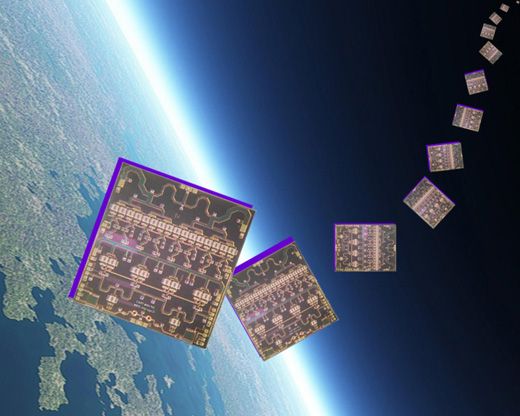Starship on a Chip
Big distance, tiny spacecraft.
/https://tf-cmsv2-smithsonianmag-media.s3.amazonaws.com/filer/starchip-388-nov06.jpg)
The news that astronomers have confirmed the presence of a planet around a nearby star is exciting, sure, but don’t expect an interstellar probe to be launched any time soon. At 10.5 light-years away, the star, Epsilon Eridani, is just around the corner, celestially speaking. But that’s still 6,774 times farther than Voyager 1, our most remote spacecraft, has managed to travel in 29 years, zipping along at a million miles a day.
You see the problem.
The fundamental challenge of time and distance has inspired many suggestions for interstellar flight, from multi-generation arks to beam-propelled star-sails. The latter, though undeniably elegant, would bankrupt whole nations just to produce the energy for the beam—if they had a beam. Still, hope springs eternal, and future-minded scientists and engineers continue to pick at the problem, hoping to find some shortcut or trick to make star travel possible.
The latest is Mason Peck, an assistant professor of mechanical and aerospace engineering at Cornell University in New York whose pre-academic career involved more conventional aerospace work at Bell Helicopter, Hughes, and Boeing. Peck wants to use natural forces to propel starships no bigger than the integrated-circuit chips in your computer.
Specifically, he would harness the Lorentz forces that drive charged particles in magnetic fields, and which physicists use to whip bits of atoms to hellacious speeds in giant particle accelerators on Earth. Jupiter, with a rapidly rotating magnetic field 20,000 times stronger than Earth’s, packs a powerful Lorentz punch. A pulsar would be even better. Spacecraft like Voyager and Cassini routinely use gravity boosts from large planets to gain acceleration; why not use Lorentz forces as a means of propulsion too? Boosts from rotating magnetic fields could theoretically accelerate spacecraft to speeds of 1 to 10 percent of the speed of light, according to Peck’s early calculations.
Because this free energy source works best on small objects, he suggests building a really tiny starship. Extrapolating from today’s state-of-the-art, he assumes we can solve the practical problems of nano-fabricating a spacecraft-on-a-chip, a single semiconductor crystal only a centimeter square and weighing less than a gram. One side would consist of solar cells for power. A rudimentary radio antenna and digital camera would be etched or deposited on the other. Attitude could be controlled by spinning the spacecraft and by torquing against the magnetic field, a technique already used for Earth-orbiting satellites.
Tied to the star-chip would be a kilometer-long, micron-thin filament that would hold enough electrostatic charge to provide the Lorentz propulsion. Since there isn’t much power or capability in a single chip, Peck envisions billions of them thousands of miles apart, forming a long communications bridge to a nearby star. Any communication would have to be simple—sending the sequence of human DNA encoded in the microcircuits, perhaps, or returning a few precious close-up pictures of a distant planet.
Peck has a grant from NASA’s Institute for Advanced Concepts, a kind of incubator for beyond-the-horizon thinking, to develop the idea further. He plans to use some of the money to study the feasibility of charging very small spacecraft in magnetic fields, and to supplement work already under way to build a simple spacecraft-on-a-chip at Cornell’s NanoScale Science and Technology Facility.
If Lorentz propulsion is practical—it’s too early to know—it could have applications for spacecraft missions within our own solar system. Better yet, it could take us to nearby stars like Epsilon Eridani with no big leaps in technology, and do it "within a lifetime or two," says Peck. That way we won’t lose interest while the probe is en route. "Humans won’t have yet evolved into some other species that doesn’t care that it actually happened," he jokes.
